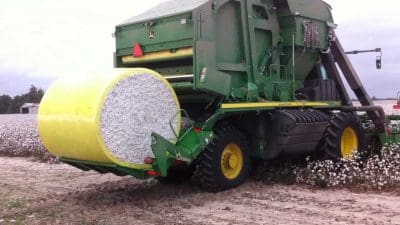PICKING of irrigated cotton crops in the key growing areas of eastern Australia is set to step into full swing after Easter, wrapping up a season that has had its challenges from high insect pressure to water shortfalls and heatwaves.

As cotton picking moves into full swing, the industry is on target to produce 4.3 to 4.4 million bales.
It has been even tougher for dryland cotton growers whose crops bore the brunt of the summer extremes.
Cotton Australia general manager, Michael Murray, said despite the conditions, the industry was still expecting to produce 4.3 to 4.4 million bales.
“It is one of the larger crops, but certainly not a record crop. We have produced over 5.0 million bales before. But anything over 4.0 million is historically a large crop,” he said.
“Prices are holding significantly above $500/bale with $530/bale to $540/bale available. On top of that growers are still getting another $20/bale to $30/bale out of seed sales.”
Cotton Seed Distributors (CSD) extension and development agronomist for Queensland, Sam Lee, said in Central Queensland where plantings were split between early-sown and late-sown crops, the early crops had been picked and ginned while the later, November/December planted crops were at cut out stage.
While the early crops yielded well, averaging between 10 and 12 bales/hectare, Mr Lee said it would be a different story with the late crops which were hit by heavy rains from Cyclone Debbie at the late-maturity stage.
“The late crops are still a few weeks off picking in mid to late May. They were opening up around the time of the rainfall off the back of Cyclone Debbie. It will affect the quality of those crops that were open or had had a defoliation. Yields will be down for the late crops compared to the early crops,” he said.
Grain Central: Get our free daily cropping news straight to your inbox – Click here
On the Darling Downs, Mr Lee said picking of irrigated crops was only just getting going and would crank up from Easter and into late April after a long dry season that ended with tail rains from the cyclone.
“Quite a few of the early irrigated crops ran out of water but there will still be some reasonable irrigated crops. And a lot of people got a reasonable pump into their ring tanks for next season,” he said.
Mr Lee said dryland picking had been underway for a month on crops in CQ and the Darling Downs that were generally down on yield and quality.
“The Downs’ dryland is not a pretty picture. It is one of the seasons that growers will want to forget fairly quickly,” he said.
“There was heavy insect pressure early in the season, then a very hot summer with no rainfall. The rain that did come was too late and came during picking, so that will downgrade quality further.
“The one positive that came out of the weather was that some areas had 200 to 300 millimetres for March which has given them full profiles for winter sowing and perhaps to carry over to summer.”
CSD extension and development agronomist at Moree in north west NSW, James Quinn, said dryland crops had had a tough time, but it was surprising how many good crops were out there.
“Most growers planted on a full profile of moisture which put them in good stead, but it goes to show the value of a storm or some rainfall in January. Some crops did it on no rain at all and they are doing it tough, but there are also some that got rainfall in January which was quite handy,” he said.
He said the harsh summer conditions had also put a lot of pressure on irrigated crops this season with growers having to carefully manage irrigation scheduling, but the crops still looked good.
“In terms of yields, they won’t be record-breaking but they will be back to what they have been in the past,” he said.
“There are yields around St George of high fours to five bales/acre (11 to 13.5 bales/hectare). We have all been spoilt in the last two years where if you didn’t get over six to seven bales/acre (15 to 17.5 bales/ha) you weren’t trying, but we have just had a correction back to where we were before that.”
In southern NSW, Mr Murray said growers were surprisingly optimistic they would achieve yields of 10 to 12 bales/hectare this season.
“Given the tough start to the season and the lateness of some of the crops there, it would have been easy to think the yields weren’t going to be that good. The warmer March probably helped them,” he said.
“Some people have just started defoliating there and picking will be three or four weeks away.”


HAVE YOUR SAY